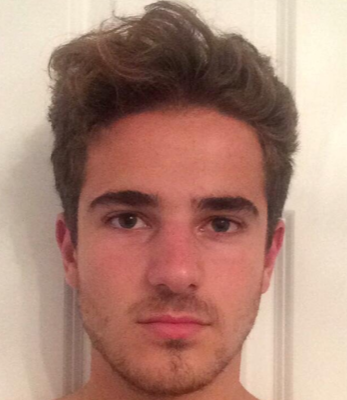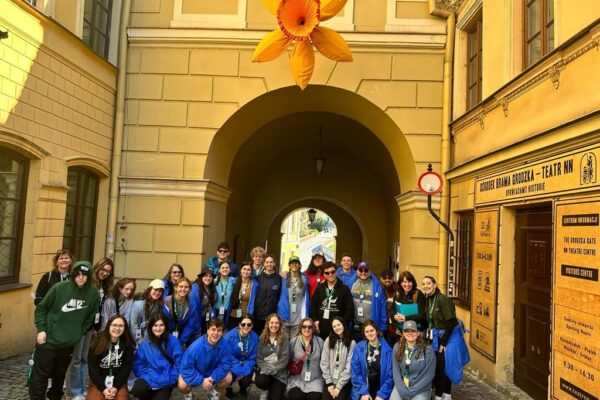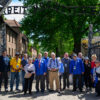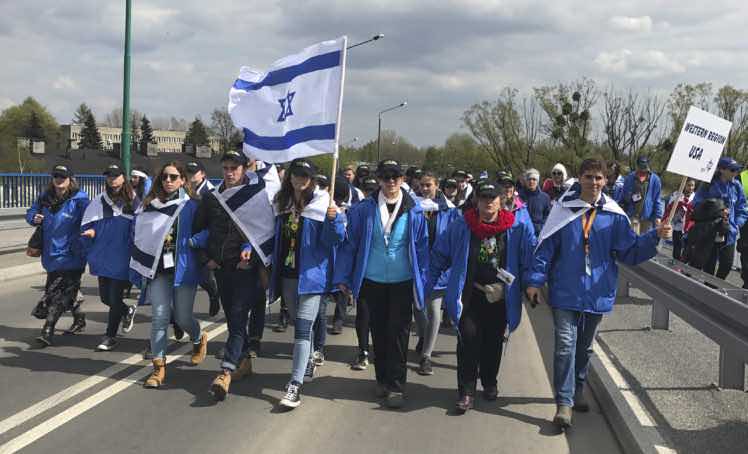
The Tucson March of the Living delegation marches from Auschwitz to Birkenau on April 24. [Courtesy Jewish Federation of Southern Arizona)
Lichter also visited the three-story house where he lived as a child with his parents, Isaac and Helena, and his older sister, Gina. The emotional attachment was gone. “It wasn’t a home anymore,” he says.
The March of the Living is a two-week trip for Jewish teenagers to Poland and Israel. The 31-member Western Region delegation included eight teens from Tucson Hebrew High, Jewish Federation of Southern Arizona Vice president and Director of the Coalition for Jewish Education Sharon Glassberg; Rabbi Stephanie Aaron of Congregation Chaverim; Jack Aaron, M.D.; and Lichter, his wife, Sara, and daughter, Tricia.
On April 24, Yom Hashoah, or Holocaust Remembrance Day, the group joined more than 10,000 Jewish teens from 40 countries, accompanied by Holocaust survivors, rabbis and other adult leaders on the three-kilometer march from Auschwitz to Birkenau.
This was Glassberg’s third MOTL. “It was very powerful,” she says. “It was a privilege to have a Holocaust survivor traveling with us to share his story and answer questions.”
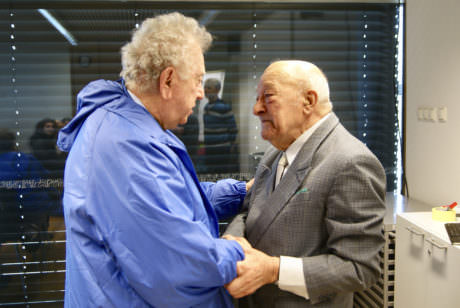
Pawel Lichter, a Holocaust survivor from Tucson, left, meets Leszek Szulc, Righteous Among the Nations, at POLIN Museum of the History of Polish Jews in Warsaw, April 22. (Courtesy Jewish Federation of Southern Arizona)
Each delegation has its own itinerary, she explains. “We visited POLIN Museum of the History of Polish Jews in Warsaw, and had the honor to hear a talk by Leszek Szulc, Righteous Among the Nations. He and his family hid and rescued 32 Jews. He told the teens, ‘You are all like my grandchildren.’” Afterward, says Glassberg, the students “went up one by one and hugged him.”
Jaden Boling, a 10th-grader at Catalina Foothills High School, received partial funding for the trip from the Jewish Federation of Southern Arizona. “I felt a personal obligation, as a young Jew, to go to Poland and see some of the places where terrible crimes against humanity occurred so I could pass on the knowledge,” he says. “Being in Pawel’s town was incredibly emotional. As we were leaving the museum in Rypin, I asked how he was feeling. He said, ‘I feel terrible.’” The exchange affected Boling deeply. “I felt like I had a piece of his personal feelings inside with my own emotions.”
During the March of the Living, Boling says, “I looked out into a sea of people all wearing MOTL blue. Myself and ten thousand others were marching in the same places our ancestors walked as prisoners because of their religion. We marched as free people.”
“In our delegation the march was a very solemn experience,” says Catalina Foothills senior Ariel Lamdan. “Nobody talked; we just marched along the road, hand in hand.”
At Auschwitz, Lichter planted a small white flag on the railroad track leading to the camp’s iron gates. On it, he wrote the names of family and friends who died in the Holocaust. Among them was Renia Rosenberg — the girl his parents planned he would marry. “We grew up together, until the tender age of 8,” he says.
During Lichter’s childhood, about half of Rypin’s approximately 20,000 inhabitants were Jews. His father, a businessman, owned a movie theater, Kino Polonia. Renia and her family, Lichter’s grandparents, uncle and several aunts lived nearby. When German soldiers entered Poland, persecution began. Through German friends, Lichter’s father obtained papers allowing his immediate family to travel. They loaded a horse-drawn wagon and headed for Russia; Lichter never saw the rest of his family again.
Several German patrols questioned them during the journey. “At the border, we were stopped by another patrol,” says Lichter. “They knew we were Jews. They searched everybody. They stripped the women. Finally, they lined us up and were going to shoot us.” An officer’s whim saved them. “My father must have reminded him of somebody. He called him Herr Professor, and said, ‘The border’s over there.’”
They found refuge in the town of Baranowicze. “Jewish people opened their homes to us, but things were very hard,” says Lichter. Some months later, Polish immigrants were offered Russian citizenship. “My mother refused,” he says. “One day, soldiers appeared.” Their family and other Jews were loaded into cattle cars and deported to Siberia. “It saved our lives. If we’d been there when the Germans invaded Russia, we would have died.”
In 1941, Poland became a Russian ally, and they were released. Until 1946 they lived in Uzbekistan, far from the battle front, suffering from hunger and persecution. They made their way back to Rypin, and learned that all Jewish inhabitants, including Lichter’s extended family, had been taken to the Warsaw ghetto or concentration camps. “I don’t know how or where they died,” he says, but “It happened. They’re not here.” To his knowledge, no Jews live in Rypin today.
Reflecting on the March of the Living, Lamdan says, “For me, it was a journey to discover my own identity as a Jew and as a human being.” Though exposed to Jewish culture all his life, he says he felt no deep personal connection until he stood in a windy field in Chelmno, Poland. “Understanding that thousands of people were killed on the ground where you stood gives you a strange, sinking feeling. The fact that the camp no longer exists, as the Nazis were trying to erase all evidence of what they had done there, gives rise to a profound hollowness. …The March of the Living has inspired me to take action, to work towards a different world where something like this will never happen again.”
The march serves an essential role in keeping the memory of the Holocaust alive, says Lichter. “It’s important to have Jewish youth keep on going over there, to keep the remembrance of these people who were murdered. By being there, they get a sense of what happened.”
After their week in Poland, the group’s mood was subdued. However, says Boling, visiting Israel was a joyful contrast. He remembers one special moment: “During Kabbalat Shabbat at the Kotel, me and a few guys were looking for a group to begin Shabbat with.” They joined some other MOTL teens and Israeli Jews. “We began by singing, or more like yelling, ‘Am Yisrael Chai.’ During those few minutes, I felt prouder than ever to be a part of the Jewish minority in the world.
“I came out of the trip with a renewed sense of Judaism. I also now take on the role of a witness; because, as Elie Wiesel says, ‘When you listen to a witness, you become a witness.’”
Originally published HERE

